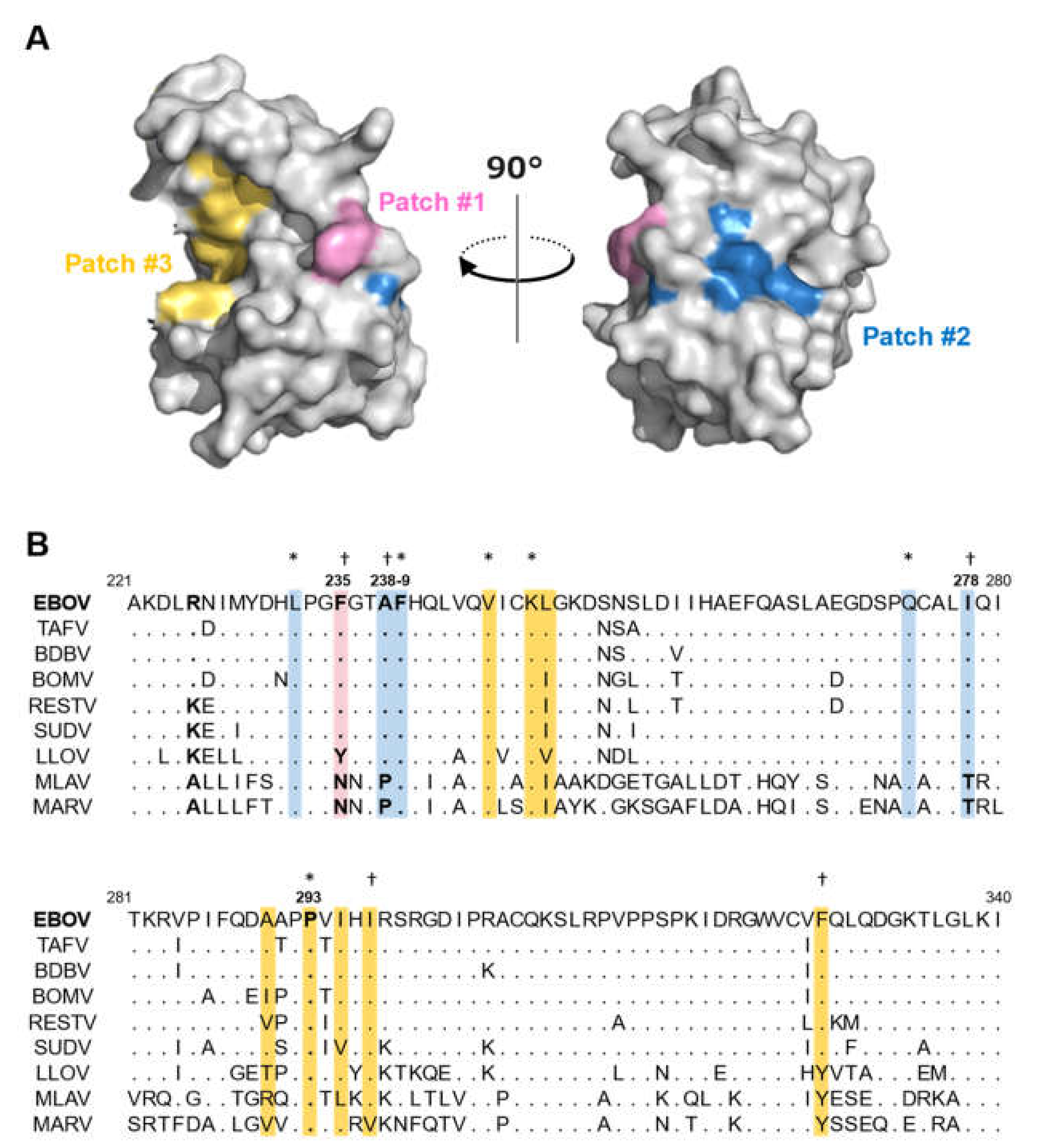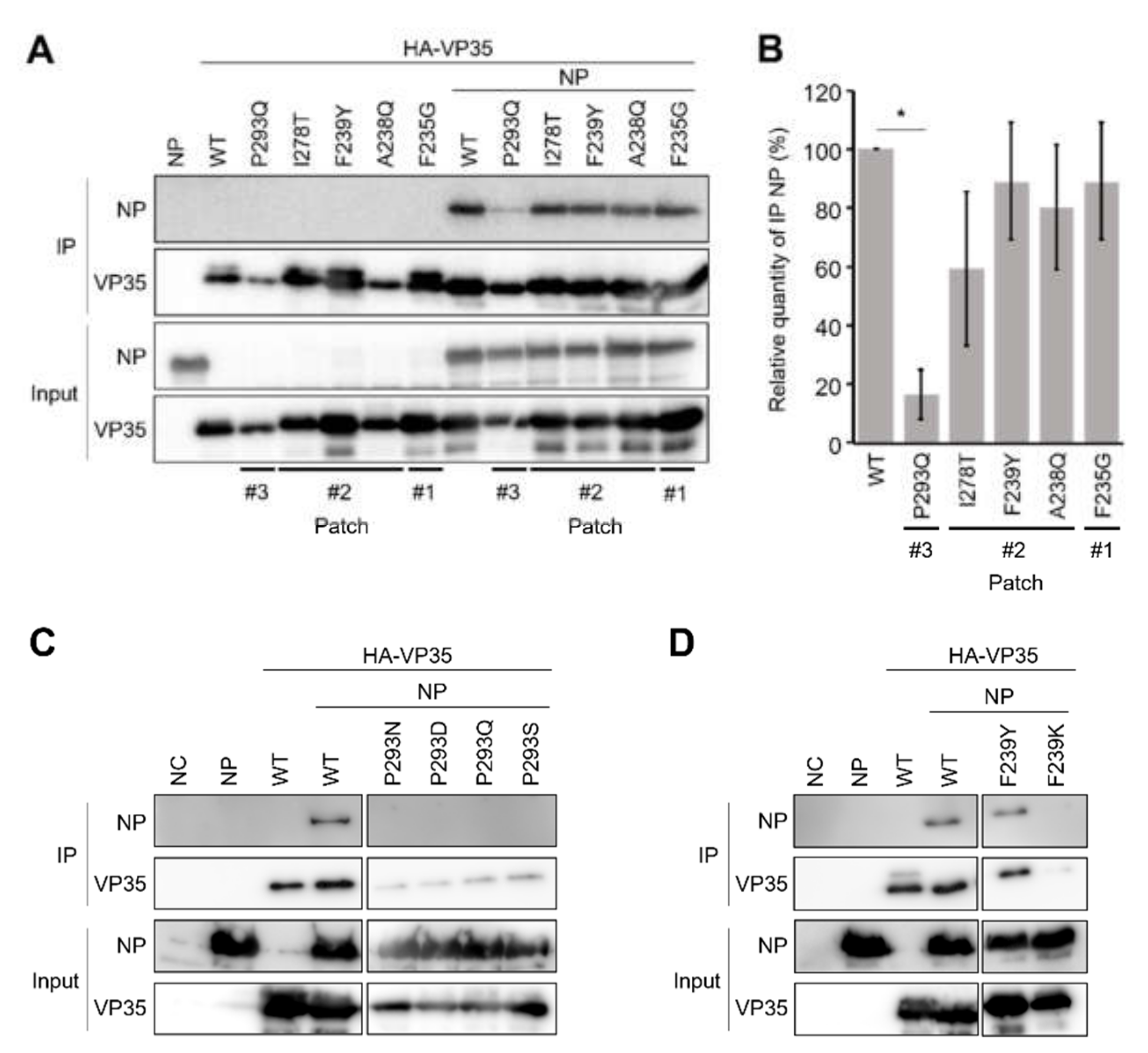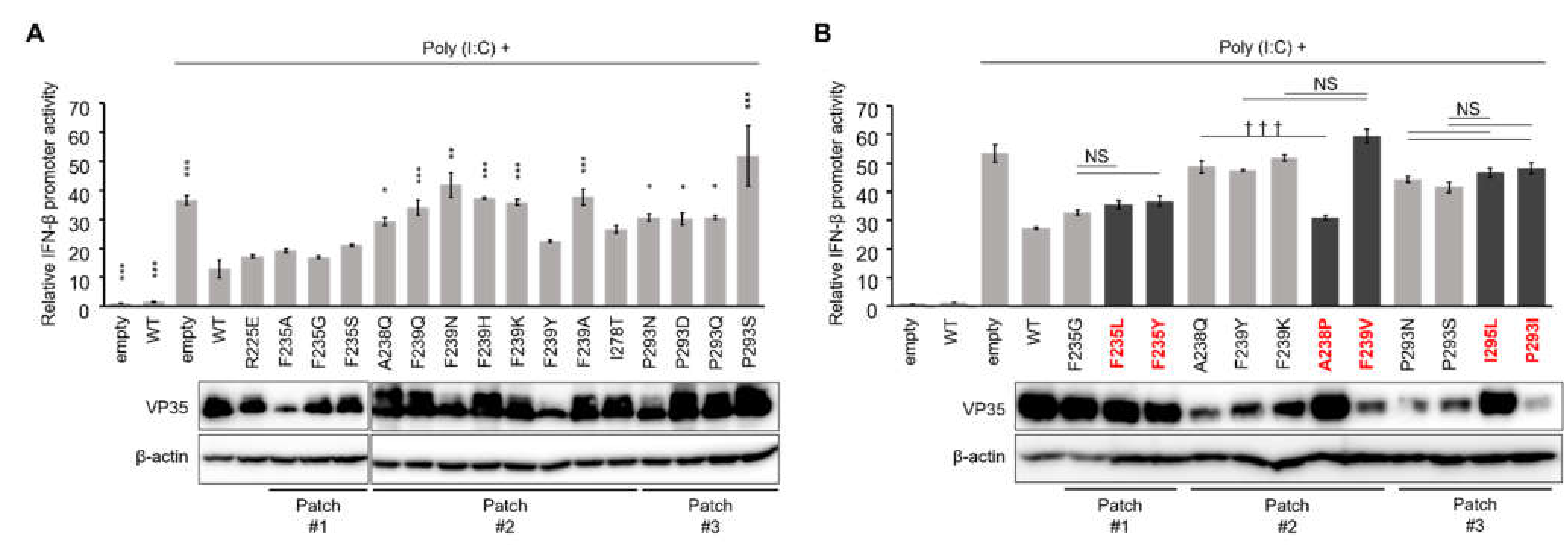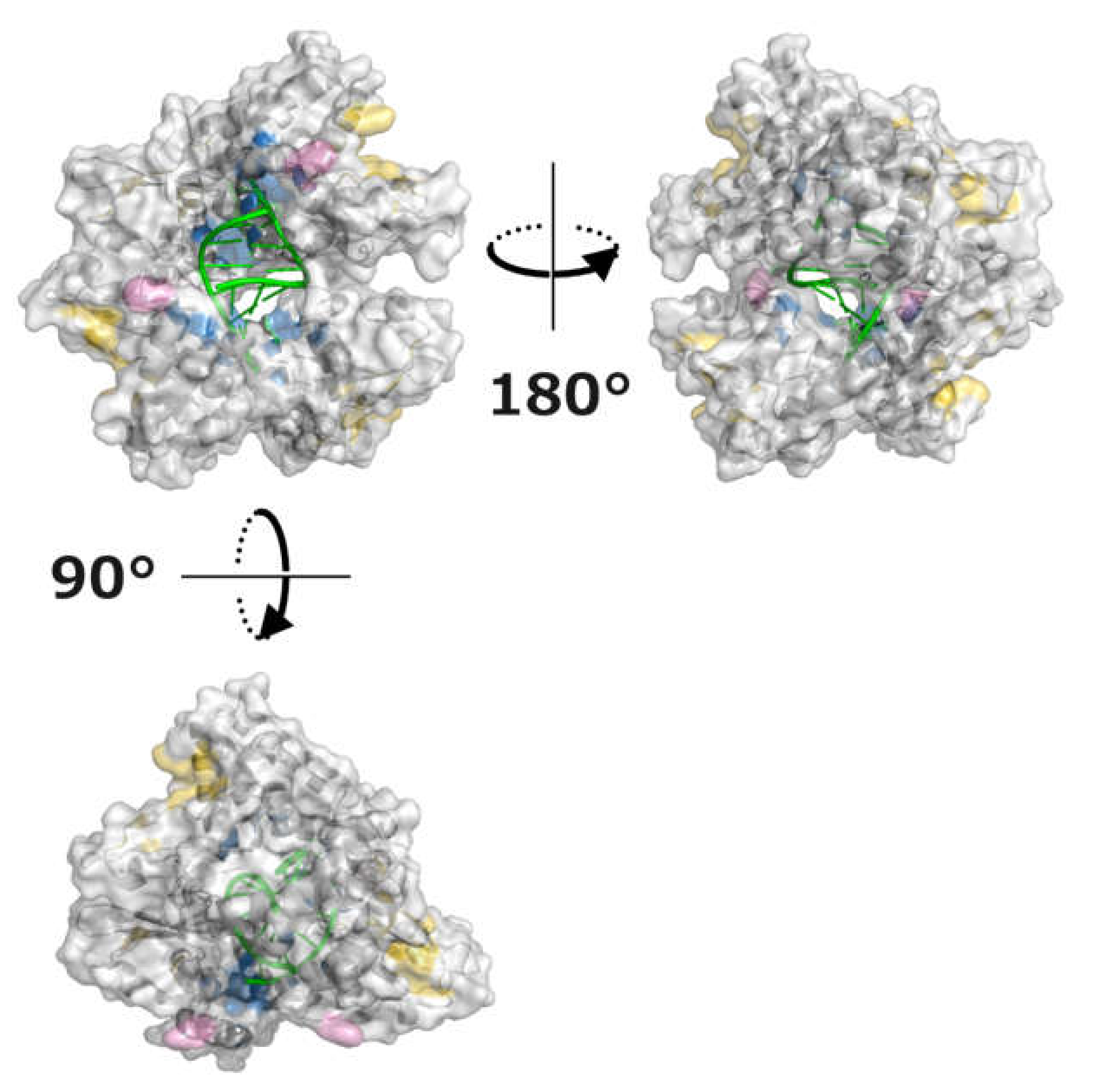Functional Importance of Hydrophobic Patches on the Ebola Virus VP35 IFN-Inhibitory Domain
Abstract
:1. Introduction
2. Materials and Methods
2.1. Patch Analysis
2.2. Cell Culture and Construction of Plasmids
2.3. Minigenome Reporter Assay
2.4. Immunoprecipitation Assay
2.5. IFN-β Promoter Reporter Assay
2.6. Statistical Analysis
3. Results
3.1. Hydrophobic Patches Present on the Surface of VP35 IID and Amino Acid Substitutions to Modify the Patch Properties
3.2. Reduced Function as a Polymerase Cofactor in Patch-Disrupted VP35 Mutants
3.3. Reduced Interaction between NP and Patch-Disrupted VP35 Mutants Having Lower Polymerase Cofactor Activity
3.4. Decreased IFN Antagonism of Patch-Disrupted VP35 Mutants
4. Discussion
Supplementary Materials
Author Contributions
Funding
Data Availability Statement
Acknowledgments
Conflicts of Interest
References
- Jacob, S.T.; Crozier, I.; Fischer, W.A.; Hewlett, A.; Kraft, C.S.; de La Vega, M.A.; Soka, M.J.; Wahl, V.; Griffiths, A.; Bollinger, L.; et al. Ebola virus disease. Nat. Rev. Dis. Primers. 2020, 6, 13. [Google Scholar] [CrossRef] [PubMed] [Green Version]
- Amarasinghe, G.K.; Aréchiga Ceballos, N.G.; Banyard, A.C.; Basler, C.F.; Bavari, S.; Bennett, A.J.; Blasdell, K.R.; Briese, T.; Bukreyev, A.; Caì, Y.; et al. Taxonomy of the order Mononegavirales: Update 2018. Arch. Virol. 2018, 163, 2283–2294. [Google Scholar] [CrossRef] [PubMed] [Green Version]
- Cross, R.W.; Mire, C.E.; Feldmann, H.; Geisbert, T.W. Post-exposure treatments for Ebola and Marburg virus infections. Nat. Rev. Drug Discov. 2018, 17, 413–434. [Google Scholar] [CrossRef] [PubMed]
- Negredo, A.; Palacios, G.; Vázquez-Morón, S.; González, F.; Dopazo, H.; Molero, F.; Juste, J.; Quetglas, J.; Savji, N.; de la Cruz Martínez, M.; et al. Discovery of an ebolavirus-like filovirus in europe. PLoS Pathog. 2011, 7, 1–8. [Google Scholar] [CrossRef] [Green Version]
- Yang, X.-L.; Tan, C.W.; Anderson, D.E.; Jiang, R.-D.; Li, B.; Zhang, W.; Zhu, Y.; Lim, X.F.; Zhou, P.; Liu, X.L.; et al. Characterization of a filovirus (Měnglà virus) from Rousettus bats in China. Nat. Microbiol. 2019, 4, 390–395. [Google Scholar] [CrossRef]
- Messaoudi, I.; Amarasinghe, G.K.; Basler, C.F. Filovirus pathogenesis and immune evasion: Insights from Ebola virus and Marburg virus. Nat. Rev. Microbiol. 2015, 13, 663–676. [Google Scholar] [CrossRef] [Green Version]
- Banerjee, A.; Pal, A.; Pal, D.; Mitra, P. Ebolavirus interferon antagonists—protein interaction perspectives to combat pathogenesis. Brief. Funct. Genom. 2017, 17, 1–10. [Google Scholar] [CrossRef]
- Prins, K.C.; Cardenas, W.B.; Basler, C.F. Ebola virus protein VP35 impairs the function of interferon regulatory factor-activating kinases IKK and TBK-1. J. Virol. 2009, 83, 3069–3077. [Google Scholar] [CrossRef] [Green Version]
- Basler, C.F.; Amarasinghe, G.K. Evasion of interferon responses by Ebola and Marburg viruses. J. Interf. Cytokine Res. 2009, 29, 511–520. [Google Scholar] [CrossRef] [Green Version]
- Reid, S.P.; Cárdenas, W.B.; Basler, C.F. Homo-oligomerization facilitates the interferon-antagonist activity of the ebolavirus VP35 protein. Virology 2005, 341, 179–189. [Google Scholar] [CrossRef] [Green Version]
- Basler, C.F.; Mikulasova, A.; Martinez-Sobrido, L.; Paragas, J.; Mühlberger, E.; Bray, M.; Klenk, H.-D.; Palese, P.; García-Sastre, A. The Ebola virus VP35 protein inhibits activation of interferon regulatory factor 3. J. Virol. 2003, 77, 7945–7956. [Google Scholar] [CrossRef] [Green Version]
- Cardenas, W.B.; Loo, Y.-M.; Gale, M.; Hartman, A.L.; Kimberlin, C.R.; Martinez-Sobrido, L.; Saphire, E.O.; Basler, C.F. Ebola virus VP35 protein binds double-stranded RNA and inhibits alpha/beta interferon production induced by RIG-I signaling. J. Virol. 2006, 80, 5168–5178. [Google Scholar] [CrossRef] [Green Version]
- Hartman, A.L.; Towner, J.S.; Nichol, S.T. A C-terminal basic amino acid motif of Zaire ebolavirus VP35 is essential for type I interferon antagonism and displays high identity with the RNA-binding domain of another interferon antagonist, the NS1 protein of influenza a virus. Virology 2004, 328, 177–184. [Google Scholar] [CrossRef] [Green Version]
- Leung, D.W.; Ginder, N.D.; Fulton, D.B.; Nix, J.; Basler, C.F.; Honzatko, R.B.; Amarasinghe, G.K. Structure of the Ebola VP35 interferon inhibitory domain. Proc. Natl. Acad. Sci. USA 2009, 106, 411–416. [Google Scholar] [CrossRef] [Green Version]
- Prins, K.C.; Binning, J.M.; Shabman, R.S.; Leung, D.W.; Amarasinghe, G.K.; Basler, C.F. Basic residues within the ebolavirus VP35 protein are required for its viral polymerase cofactor function. J. Virol. 2010, 84, 10581–10591. [Google Scholar] [CrossRef] [Green Version]
- Leung, D.W.; Prins, K.C.; Borek, D.M.; Farahbakhsh, M.; Tufariello, J.M.; Ramanan, P.; Nix, J.C.; Helgeson, L.A.; Otwinowski, Z.; Honzatko, R.B.; et al. Structural basis for dsRNA recognition and interferon antagonism by Ebola VP35. Nat. Struct. Mol. Biol. 2010, 17, 165–172. [Google Scholar] [CrossRef] [Green Version]
- Prins, K.C.; Delpeut, S.; Leung, D.W.; Reynard, O.; Volchkova, V.A.; Reid, S.P.; Ramanan, P.; Cardenas, W.B.; Amarasinghe, G.K.; Volchkov, V.E.; et al. Mutations abrogating VP35 interaction with double-stranded RNA render Ebola virus avirulent in Guinea Pigs. J. Virol. 2010, 84, 3004–3015. [Google Scholar] [CrossRef] [Green Version]
- Hartman, A.L.; Bird, B.H.; Towner, J.S.; Antoniadou, Z.-A.; Zaki, S.R.; Nichol, S.T. Inhibition of IRF-3 activation by VP35 is critical for the high level of virulence of Ebola virus. J. Virol. 2008, 82, 2699–2704. [Google Scholar] [CrossRef] [Green Version]
- Jones, S.; Thornton, J.M. Analysis of protein-protein interaction sites using surface patches. J. Mol. Biol. 1997, 272, 121–132. [Google Scholar] [CrossRef]
- Jones, S.; Thornton, J.M. Prediction of protein-protein interaction sites using patch analysis. J. Mol. Biol. 1997, 272, 133–143. [Google Scholar] [CrossRef]
- Niwa, H.; Yamamura, K.; Miyazaki, J. Efficient secletion for high-expression transformants with a novel eukaryotic vector. Gene 1991, 108, 193–199. [Google Scholar]
- Kondoh, T.; Manzoor, R.; Nao, N.; Maruyama, J.; Furuyama, W.; Miyamoto, H.; Shigeno, A.; Kuroda, M.; Matsuno, K.; Fujikura, D.; et al. Putative endogenous filovirus VP35-like protein potentially functions as an IFN antagonist but not a polymerase cofactor. PLoS ONE 2017, 12, e0186450. [Google Scholar] [CrossRef] [Green Version]
- Watanabe, S.; Noda, T.; Halfmann, P.; Jasenosky, L.; Kawaoka, Y. Ebola virus (EBOV) VP24 inhibits transcription and replication of the EBOV genome. J. Infect. Dis. 2007, 196, S284–S290. [Google Scholar] [CrossRef] [Green Version]
- Watanabe, S.; Watanabe, T.; Noda, T.; Feldmann, H.; Jasenosky, L.D.; Takada, A.; Kawaoka, Y. Production of novel Ebola virus-like particles from cDNAs: An alternative to Ebola virus generation by reverse genetics. J. Virol. 2004, 78, 999–1005. [Google Scholar] [CrossRef] [Green Version]
- Changula, K.; Yoshida, R.; Noyori, O.; Marzi, A.; Miyamoto, H.; Ishijima, M.; Yokoyama, A.; Kajihara, M.; Feldmann, H.; Mweene, A.S.; et al. Mapping of conserved and species-specific antibody epitopes on the Ebola virus nucleoprotein. Virus Res. 2013, 176, 83–90. [Google Scholar] [CrossRef] [Green Version]
- Team, R.C. R: A Language and Environment for Statistical Computing. Available online: https://www.r-project.org/ (accessed on 15 September 2021).
- Kimberlin, C.R.; Bornholdt, Z.A.; Li, S.; Woods, V.L.; MacRae, I.J.; Saphire, E.O. Ebolavirus VP35 uses a bimodal strategy to bind dsRNA for innate immune suppression. Proc. Natl. Acad. Sci. USA 2010, 107, 314–319. [Google Scholar] [CrossRef] [Green Version]
- Haasnoot, J.; De Vries, W.; Geutjes, E.J.; Prins, M.; De Haan, P.; Berkhout, B. The ebola virus VP35 protein is a suppressor of RNA silencing. PLoS Pathog. 2007, 3, 0794–0803. [Google Scholar] [CrossRef]
- Becker, S.; Rinne, C.; Hofsäß, U.; Klenk, H.D.; Mühlberger, E. Interactions of Marburg virus nucleocapsid proteins. Virology 1998, 249, 406–417. [Google Scholar] [CrossRef] [Green Version]
- Muhlberger, E.M.; Weik, M.; Volchkov, V.E.; Klenk, H.-D.D.; Becker, S.; Mühlberger, E.; Weik, M.; Volchkov, V.E.; Klenk, H.-D.D.; Becker, S. Comparison of the transcription and replication strategies of Marburg virus and Ebola virus by using artificial replication systems. J. Virol. 1999, 73, 2333–2342. [Google Scholar] [CrossRef] [Green Version]
- Marnolia, A.; Toepak, E.P.; Tambunan, U.S.F. Fragment-based lead compound design to inhibit Ebola VP35 through computational studies. Int. J. Geomate 2018, 15, 65–71. [Google Scholar] [CrossRef]
- Zhang, Y.J.; Ding, J.N.; Zhong, H.; Sun, C.P.; Han, J.G. Molecular dynamics exploration of the binding mechanism and properties of single-walled carbon nanotube to WT and mutant VP35 FBP region of Ebola virus. J. Biol. Phys. 2017, 43, 149–165. [Google Scholar] [CrossRef] [PubMed] [Green Version]
- Brown, C.S.; Lee, M.S.; Leung, D.W.; Wang, T.; Xu, W.; Luthra, P.; Anantpadma, M.; Shabman, R.S.; Melito, L.M.; MacMillan, K.S.; et al. In silico derived small molecules bind the filovirus VP35 protein and inhibit its polymerase co-factor activity. J. Mol. Biol. 2014, 426, 2045–2058. [Google Scholar] [CrossRef] [PubMed] [Green Version]
- Ramanan, P.; Edwards, M.R.; Shabman, R.S.; Leung, D.W.; Endlich-Frazier, A.C.; Borek, D.M.; Otwinowski, Z.; Liu, G.; Huh, J.; Basler, C.F.; et al. Structural basis for Marburg virus VP35-mediated immune evasion mechanisms. Proc. Natl. Acad. Sci. USA 2012, 109, 20661–20666. [Google Scholar] [CrossRef] [PubMed] [Green Version]
- Feagins, A.R.; Basler, C.F. Lloviu virus VP24 and VP35 proteins function as innate immune antagonists in human and bat cells. Virology 2015, 485, 145–152. [Google Scholar] [CrossRef]
- Williams, C.G.; Gibbons, J.S.; Keiffer, T.R.; Luthra, P.; Edwards, M.R.; Basler, C.F. Impact of Měnglà virus proteins on human and bat innate immune pathways. J. Virol. 2020, 94, e00191-20. [Google Scholar] [CrossRef]





| Patch | Mutation | dStability 1 | Difference in Patch Area 2 | Number of Patches | ||||
|---|---|---|---|---|---|---|---|---|
| Hydrophobic | Positively Charged | Negatively Charged | Hydrophobic | Positively Charged | Negatively Charged | |||
| #1 | F235F | 0.00 | 0 | 0 | 0 | 3 | 8 | 6 |
| F235A3 | 0.73 | −100 | 0 | 0 | 2 | 8 | 6 | |
| F235G3 | 0.51 | −100 | 0 | 0 | 2 | 8 | 6 | |
| F235S3 | 0.96 | −100 | 0 | 0 | 2 | 8 | 6 | |
| F235L 4 | 0.37 | −10 | 0 | 0 | 3 | 8 | 6 | |
| F235Y 4 | 0.79 | −10 | 0 | 0 | 3 | 8 | 6 | |
| #2 | A238A | 0.00 | 0 | 0 | 0 | 3 | 8 | 6 |
| A238Q 3 | 1.55 | −70 | 0 | 0 | 2 | 8 | 6 | |
| A238P 4 | 0.56 | 0 | 0 | 0 | 3 | 8 | 6 | |
| F239F | 0.00 | 0 | 0 | 0 | 3 | 8 | 6 | |
| F239Q3 | 1.31 | −70 | 0 | 0 | 2 | 8 | 6 | |
| F239N3 | 1.86 | −70 | 0 | 0 | 2 | 8 | 6 | |
| F239H3 | 1.84 | −70 | 0 | 0 | 2 | 8 | 6 | |
| F239K3 | 1.90 | −70 | 60 | 0 | 2 | 9 | 6 | |
| F239A3 | 1.91 | −20 | 10 | 0 | 2 | 8 | 6 | |
| F239Y3 | 0.74 | −70 | 0 | 0 | 2 | 8 | 6 | |
| F239V 4 | 1.83 | 0 | 0 | 0 | 3 | 8 | 6 | |
| I278I | 0.00 | 0 | 0 | 0 | 3 | 8 | 6 | |
| I278T3 | 1.66 | −80 | 0 | 0 | 2 | 8 | 6 | |
| #3 | P293P | 0.00 | 0 | 0 | 0 | 3 | 8 | 6 |
| P293N3 | 1.04 | −110 | 0 | 0 | 2 | 8 | 6 | |
| P293D3 | 1.33 | −110 | 0 | 0 | 2 | 8 | 6 | |
| P293Q3 | 0.69 | −110 | 0 | 0 | 2 | 8 | 6 | |
| P293S3 | 1.26 | −110 | 0 | 0 | 2 | 8 | 6 | |
| P293I 4 | 0.02 | 0 | 0 | 0 | 3 | 8 | 6 | |
| I295L 4 | 0.75 | 0 | 0 | 0 | 3 | 8 | 6 | |
Publisher’s Note: MDPI stays neutral with regard to jurisdictional claims in published maps and institutional affiliations. |
© 2021 by the authors. Licensee MDPI, Basel, Switzerland. This article is an open access article distributed under the terms and conditions of the Creative Commons Attribution (CC BY) license (https://creativecommons.org/licenses/by/4.0/).
Share and Cite
Kasajima, N.; Matsuno, K.; Miyamoto, H.; Kajihara, M.; Igarashi, M.; Takada, A. Functional Importance of Hydrophobic Patches on the Ebola Virus VP35 IFN-Inhibitory Domain. Viruses 2021, 13, 2316. https://doi.org/10.3390/v13112316
Kasajima N, Matsuno K, Miyamoto H, Kajihara M, Igarashi M, Takada A. Functional Importance of Hydrophobic Patches on the Ebola Virus VP35 IFN-Inhibitory Domain. Viruses. 2021; 13(11):2316. https://doi.org/10.3390/v13112316
Chicago/Turabian StyleKasajima, Nodoka, Keita Matsuno, Hiroko Miyamoto, Masahiro Kajihara, Manabu Igarashi, and Ayato Takada. 2021. "Functional Importance of Hydrophobic Patches on the Ebola Virus VP35 IFN-Inhibitory Domain" Viruses 13, no. 11: 2316. https://doi.org/10.3390/v13112316
APA StyleKasajima, N., Matsuno, K., Miyamoto, H., Kajihara, M., Igarashi, M., & Takada, A. (2021). Functional Importance of Hydrophobic Patches on the Ebola Virus VP35 IFN-Inhibitory Domain. Viruses, 13(11), 2316. https://doi.org/10.3390/v13112316








